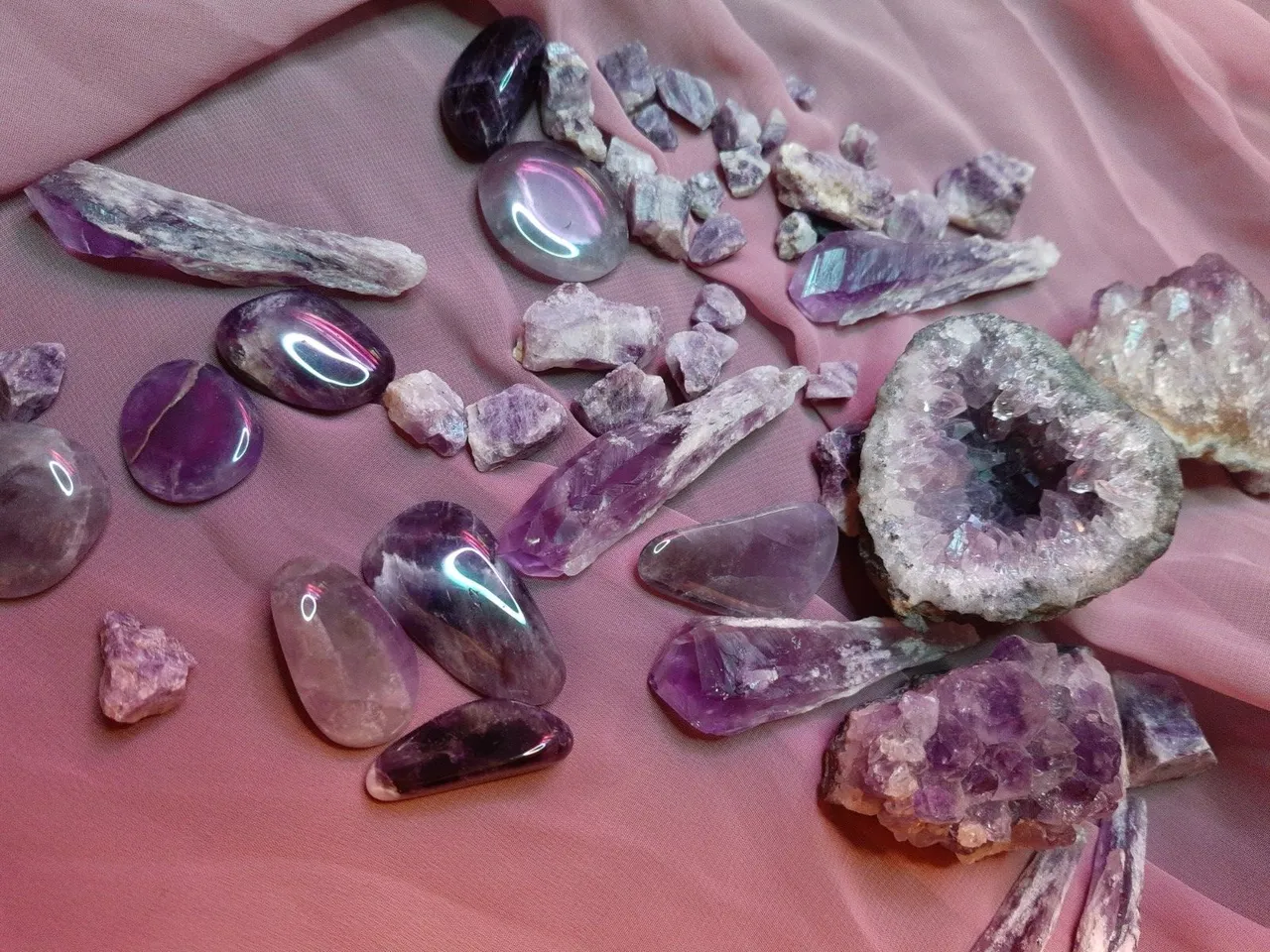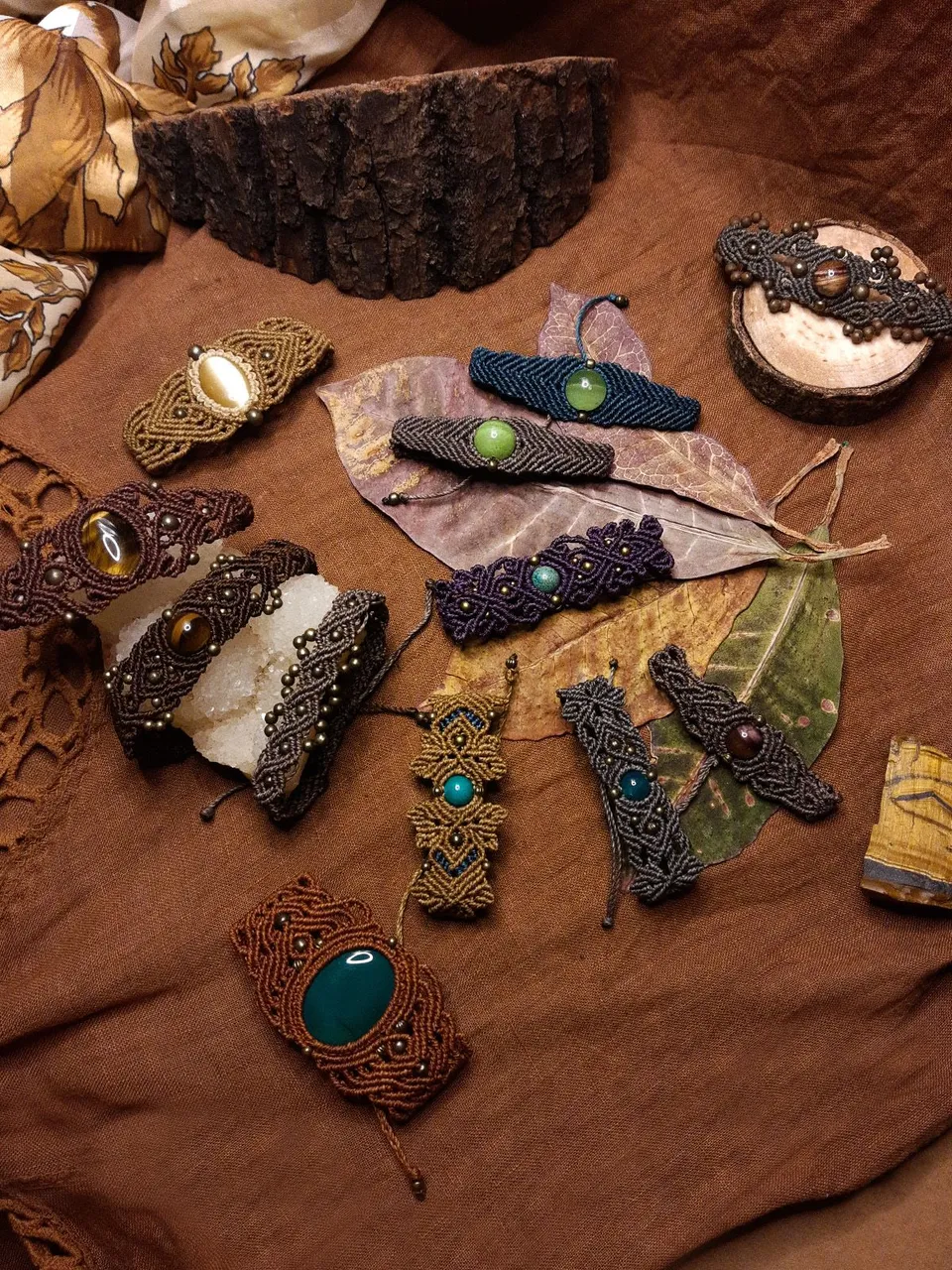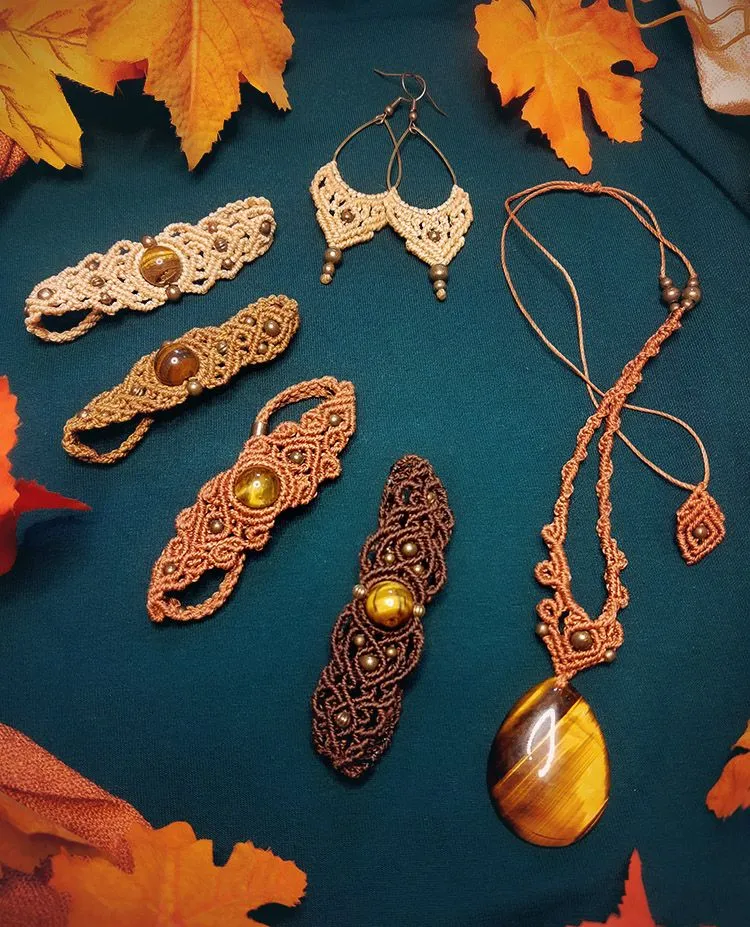[english version below]
Kamienie lecznicze
Każdy z nas doskonale zdaje sobie sprawę, jak połyskliwy kawałek wyszlifowanej skały może dodać uroku osobie, która go nosi w formie naszyjnika, pierścionka czy kolczyków. Nasze upodobanie do brylantów oraz kruszców, takich jak złoto czy srebro, jest tak samo wyraźne jak setki, a nawet tysiące lat temu. Kamienie szlachetne odnajdywano już w grobowcach starożytnych kultur, od cywilizacji Olmeków w Ameryce Środkowej po piramidy faraonów w starożytnym Egipcie, ale ludzkość zapewne znała kamienie szlachetne o wiele dłużej.

Niezwykła prawidłowość kształtu minerałów od dawna była czym zachwycającym dla ludzi, a jej symetria i doskonałość, wynikające z działania praw natury, przez tysiąclecia pobudzała fantazję badaczy, doprowadzając w końcu do odkrycia wewnętrznej budowy kryształów. Wielcy greccy filozofowie, tacy jak Arystoteles czy Teofrastos, zwracali szczególną uwagę na minerały i wyróżniali oni ponad sześćdziesiąt typów mineralnych na podstawie cech, np podatności na obrabianie, palność lub charakter metaliczny. Wiedza ta została zaadaptowana i rozwinięta przez arabskich lekarzy, już w okolicach roku 1000 Al-Biruni potrafił stosować fizyczne metody dokładnego oznaczania gęstości minerałów. Jako pierwszy zauważył także drobne inkluzje płynów wewnątrz kryształów i trafnie uznał je za pozostałości ośrodków, w jakich owe kryształy powstawały.
Prawdopodobnie najistotniejsze odkrycie, które pomogło ustalić wewnętrzną strukturę minerałów, miało miejsce w 1669 roku i było wynikiem działań duńskiego badacza Nielsa Steno. Mierzył on za pomocą goniometru kontaktowego i kątomierza kąty między odpowiednimi ścianami prawidłowo wykształconych kwarców, co zaowocowało stwierdzeniem, że kąt pomiędzy parami tych samych ścian był zawsze taki sam. Steno nazwał tę podstawową dla krystalografii zasadę prawem stałości kątów między ścianami, co stało się później podstawą do wydzielenia siedmiu układów krystalograficznych; już wtedy rozumiał, że ta zewnętrzna prawidłowość musi wynikać z jakiegoś wewnętrznego porządku w kryształach. Dopiero na przełomie XVIII i XIX wieku pewne pechowe wydarzenie i zainicjowane przez nie eksperymenty potwierdziły to przypuszczenie. Francuski mineralog Rene J. Haüy, oglądając pewnego razu zbiór mineralogiczny jednego ze swoich przyjaciół, upuścił na ziemię piękny kryształ kalcytu, który w wyniku upadku rozpadł się na drobne fragmenty. Przyglądając się im dokładniej, badacz zaobserwował, że wszystkie niezliczone odłamki były do siebie podobne - stanowiły one bryły ograniczone sześcioma rombami (czyli romboedry), a kąty między odpowiednimi ścianami tych romboedrów były zawsze jednakowe. Nawet drobinki, które badał później pod mikroskopem, wykazywały tą właściwość.
Czym zatem są kryształy?
Są to twory o wysoce uporządkowanej budowie wewnętrznej, polegającej na bardzo prawidłowym ułożeniu atomów, cząsteczek lub jonów, mają one w strukturze kryształu swoje stałe miejsca. Stan krystaliczny nie jest niczym niezwykłym, ponieważ cała skorupa ziemska jest niemal całkowicie zbudowana z kryształów, a poza nią cała różnorodność produktów technologicznych - metale i stopy, organiczne i nieorganiczne związki chemiczne, a także na przykład szkielety ssaków, muszle ślimaków czy małży lub kolce jeżowca!
Wszystkie kryształy, które powstały w przyrodzie samoistnie i bez udziału człowieka czy technologii nazywamy minerałami. Znaczenie minerałów dla ludzkości jest trudne do przecenienia; tworzą dziś podstawę dla wszystkich naukowych technologii, są one źródłem materiałów budowlanych I kruszców, wykorzystuje się je przy produkcji szkła, ceramiki i dla całego przemysłu chemii nieorganicznej. Bez nich nie byłoby możliwe powstanie i rozwój życia, ponieważ składniki podstawowe materii żywej i ważne dla procesów życiowych pierwiastki śladowe pochodzą z minerałów.
Działanie lecznicze
Mimo, iż współczesna nauka nie potrafi jeszcze odpowiedzieć na pytanie, w jaki sposób działa lecznicza moc kamieni, to szamani, uzdrowiciele i znachorzy korzystali (i wciąż korzystają) z ich energii w procesach leczenia. Jedno z potencjalnych wytłumaczeń uzdrawiających właściwości kryształów odnosi się do zdolności kryształów do wytwarzania ładunku elektrycznego pod wpływem temperatury lub pod wpływem naprężeń mechanicznych, inne wytłumaczenia mówią o efekcie placebo lub po prostu o magii.
Nieco więcej światła na sprawę mogą rzucić odkrycia dotyczące fizyki kwantowej oraz falowej natury rzeczywistości. Biorąc pod uwagę niezwykle harmoniczną budowę cząsteczkową minerałów można wysunąć wniosek, analogicznie, o ich harmonicznej strukturze falowej. Zatem, idąc dalej tym tropem, energia falowa kamieni wpływa na swoje najbliższe otoczenie i harmonizuje nasze ciała energetyczne (fizyczne, eteryczne, astralne oraz mentalne). Należy zdać sobie sprawę, że praca z tak subtelnymi energiami jest tym skuteczniejsza, im większa jest świadomość płaszczyzn, na które wpływają. Dobrze jest zatem zapoznać się dokładnie z powyższymi zagadnieniami i zdać się w głównej mierze na własną intuicję, ponieważ nie ma jednej słusznej metody na pracę z kamieniami , a mówiąc ściślej - ilu terapeutów, tyle metod - ważne, by wsłuchać się w siebie.
Przy leczeniu kamieniami warto sięgnąć po biżuterię z nimi, taką jak naszyjniki, bransolety, pierścionki lub kolczyki, albo po prostu nosić je ze sobą w kieszeni, czy przykładać w miejsce wymagające uzdrowienia, skupiając się jednocześnie na intencji zdrowia i prawidłowego przepływu energii. Może się okazać, że któryś kamień będzie wywoływał w nas efekt odwrotny do zamierzonego, wówczas możemy jasno stwierdzić, że kamień ów nie jest energetycznie zgodny z nami.
Przy wyborze minerału powinniśmy się kierować tym, co się nam podoba, nie zastanawiać się zbyt długo. Zazwyczaj kamień, który ma dla nas największy terapeutyczny potencjał to ten, który zauważyliśmy jako pierwszy lub który zwyczajnie wydaje nam się najatrakcyjniejszy. Przy wyborze kamienia dla siebie lub dla kogoś możemy zwrócić również uwagę na korespondencje ze znakami zodiaku. Kształt również nie jest bez znaczenia. Formy obłe, okrągłe, jajowate, eliptyczne, związane są bardziej z aspektem intuicji i naszej duchowości, natomiast formy kanciate, kwadratowe, twarde, wiążą się z płaszczyzną materialną i naszą zdolnością wpływania na plan fizyczny.
Nasz minerał lub biżuterię z nim możemy kłaść pod swoją poduszkę na noc, a także wystawiać go do słońca lub księżyca, żeby go nieco “naładować”. Pamiętajmy także, aby kamienie regularnie oczyszczać - jest kilka skutecznych metod, spośród których można wymienić okadzanie (np białą szałwią lub kadzidłem), oczyszczanie dźwiękiem (dzwonki tybetańskie), oczyszczanie w żywiołach (np całonocna kąpiel w słonej wodzie) lub oczyszczanie przy pomocy kwarcu (np przy pomocy geody ametystowej).
Woda, do której włożymy dany minerał (z racji na swoją możliwość strukturyzacji), również nabiera jego właściwości - efekt ten możemy spotęgować wystawiając naczynie z wodą i kryształem na kilka godzin do słońca. Powstały eliksir możemy także zakonserwować alkoholem i spożywać po kilka kropel dwa razy dziennie, aby przywrócić równowagę energetyczną zaburzoną przez negatywne myśli i emocje. Spożywanie może być stosowane wspomagająco przy każdej innej formie leczenia nie zakłócając jego przebiegu.
Gdzie mogę zdobyć własny kamień?
W dzisiejszych czasach zainteresowanie kamieniami szlachetnymi stale rośnie, zarówno ze względów ozdobnych, kolekcjonerskich jak i zdrowotnych. Internet oferuje nam mnogość ofert i kusi atrakcyjnymi cenami, ale jest też pewien szkopuł - masa podróbek, na które nabierają się często ludzie dopiero poznający temat. Często dystrybutorzy nie informują nas, czy kamień jest naturalny, czy syntetyczny, a sam wygląd okazuje się niewystarczający, aby odróżnić podróbkę. Kamień naturalny często jest blisko sto razy droższy od syntetycznego (!), zatem jeśli cena wydaje nam się podejrzanie niska, najpewniej mamy do czynienia z plastikiem.
Regularnie odbywają się w wielu krajach giełdy minerałów, na których nie tylko mamy ogromny wybór kamieni szlachetnych, ale możemy także spotkać ludzi, od których takie kamienie chcielibyśmy nabyć. Dzięki temu mamy możliwość poznać pochodzenie kryształów i dowiedzieć się czegoś na ich temat od specjalistów w tej dziedzinie.
Jeżeli w dalszym ciągu nie masz pewności, jakiego dokonać wyboru lub wyprawa na giełdę nie jest dla Ciebie wygodną opcją, w naszym sklepie oferujemy wyselekcjonowane przez nas kamienie naturalne oraz biżuterię z kryształami wykonywaną ręcznie i oczyszczaną przed wysyłką. Nasi artyści tworzą również biżuterię na specjalne zamówienie, dobierając dokładnie kamień do osoby, która będzie go później nosić. Taka biżuteria ma w sobie nie tylko urok, ale przede wszystkim duszę - intencję pełni zdrowia i harmonii. Zachęcamy do zapoznania się z naszą ofertą, a także do konsultacji - pomożemy dobrać kamień do Twoich potrzeb (www.misteriada.com)


[ENGLISH VERSION]
Healing stones
Each of us is well aware of how a shiny piece of polished rock can add beauty to the person who wears it in the form of a necklace, ring, or earrings. Our predilection for diamonds and bullion, such as gold and silver, is as clear as it was hundreds or even thousands of years ago. Gemstones have already been found in the tombs of ancient cultures, from the Olmec civilization in Central America to the pyramids of the Pharaohs in ancient Egypt, but mankind has probably known gemstones for much longer.

The unusual regularity of the shape of minerals has long been something that has delighted people, and its symmetry and perfection, resulting from the operation of the laws of nature, have stimulated the imagination of researchers for millennia, eventually leading to the discovery of the internal structure of crystals. Great Greek philosophers such as Aristotle and Theophrastos paid special attention to minerals, and they distinguished more than sixty mineral types based on characteristics, such as machinability, combustibility, or metallic character. This knowledge was adapted and developed by Arab physicians, as early as around the year 1000 Al-Biruni was able to use physical methods to accurately determine the density of minerals. He was also the first to notice tiny fluid inclusions inside crystals and accurately recognized them as remnants of the centers in which these crystals were formed.
Probably the most significant discovery that helped determine the internal structure of minerals took place in 1669 and was the result of Danish researcher Niels Steno. He measured with a contact goniometer and protractor the angles between the corresponding walls of properly formed quartzes, which resulted in the finding that the angle between pairs of the same walls was always the same. Steno called this fundamental principle for crystallography the law of constancy of angles between walls, which later became the basis for the separation of seven crystallographic systems; even then he understood that this external regularity must result from some internal order in the crystals. It was not until the turn of the 18th century that a certain unlucky event and the experiments it initiated confirmed this conjecture. French mineralogist Rene J. Haüy, once looking at the mineralogical collection of one of his friends, dropped a beautiful calcite crystal on the ground, which, as a result of the fall, broke into small fragments. Looking at them more closely, the researcher observed that all the myriad fragments were similar to each other - they were solids bounded by six rhombuses (or rhombohedra), and the angles between the corresponding faces of these rhombohedra were always equal. Even the particles he later examined under the microscope exhibited this property.
What then are crystals?
They are formations with a highly ordered internal structure, consisting of a very correct arrangement of atoms, molecules, or ions; they have their fixed places in the crystal structure. The crystalline state is not unusual, since the entire Earth's crust is almost entirely made up of crystals and beyond that a whole variety of technological products - metals and alloys, organic and inorganic chemical compounds, as well as, for example, mammalian skeletons, snail or mussel shells or sea urchin spines!
All crystals that have formed in nature spontaneously and without human intervention or technology are called minerals. The importance of minerals to mankind can hardly be overestimated; they form the basis for all scientific technologies today, they are the source of building materials AND bullion, and they are used in the production of glass, ceramics, and for the entire inorganic chemistry industry. Without them, the origin and development of life would not have been possible, since the basic components of living matter and important trace elements for life processes are derived from minerals.
Medicinal effects
Although modern science cannot yet answer the question of how the healing power of stones works, shamans, healers, and quacks have used (and still use) their energy in healing processes. One potential explanation for the healing properties of crystals relates to the ability of crystals to produce an electrical charge when exposed to temperature or under mechanical stress, other explanations speak of a placebo effect or simply magic.
A little more light may be shed on the matter by discoveries about quantum physics and the wave nature of reality. Taking into account the extremely harmonic molecular structure of minerals, one can conclude, by analogy, about their harmonic wave structure. So, following this line, the wave energy of stones affects their immediate environment and harmonizes our energy bodies (physical, etheric, astral, and mental). It is important to realize that working with such subtle energies is all the more effective the greater the awareness of the planes they affect. Therefore, it is good to thoroughly familiarize yourself with the above issues and rely mainly on your intuition, because there is no one right way to work with stones, and to be more precise - how many therapists, how many methods - the important thing is to listen to yourself.
When healing with stones, it is worth reaching for jewelry with them, such as necklaces, bracelets, rings, or earrings, or simply carry them with you in your pocket or apply them to the place that needs healing, while focusing on the intention of health and proper energy flow. It may turn out that any stone will have the opposite effect on us, in which case we can make it clear that the stone is not energetically compatible with us.
When choosing a mineral, we should be guided by what we like, and not think too long. Usually, the stone that has the greatest therapeutic potential for us is the one that we noticed first or that simply seems most attractive to us. When choosing a stone for ourselves or someone, we can also pay attention to correspondences with zodiac signs. The shape is also not without significance. Oblique, round, egg-shaped, elliptical forms are associated more with the aspect of intuition and our spirituality, while angular, square, and hard forms are associated with the material plane and our ability to influence the physical plane.
We can put our minerals or jewelry with it under our pillow at night, and expose it to the sun or moon to "charge" it a bit. We should also remember to cleanse the stones regularly - there are several effective methods, among which we can mention inoculation (e.g. with white sage or incense), sound cleansing (Tibetan bells), cleansing in the elements (e.g. an all-night bath in salt water) or cleansing with quartz (e.g. with an amethyst geode).
The water into which we put the mineral (due to its ability to structure) also acquires its properties - this effect can be intensified by exposing the vessel with water and crystal to the sun for several hours. The resulting elixir can also be preserved with alcohol and consumed a few drops twice a day to restore the energy balance disturbed by negative thoughts and emotions. Consumption can be used adjunctively with any other form of treatment without interfering with it.
Where can I get my stone?
Nowadays, interest in gemstones is growing steadily for ornamental, collector, and health reasons. The Internet offers us a multitude of deals and tempts us with attractive prices, but there is also a skeleton - a mass of fakes, which are often fooled by people just learning about the subject. Often distributors do not inform us whether the stone is natural or synthetic, and appearance alone proves insufficient to distinguish a fake. Natural stone is often nearly a hundred times more expensive than synthetic (!), so if the price seems suspiciously low to us, we are most likely dealing with plastic.
Mineral exchanges are held regularly in many countries, where not only do we have a huge selection of gemstones, but we can also meet people from whom we would like to purchase such stones. This gives us the opportunity to learn about the origin of crystals and to learn something about them from specialists in the field.
If you are still not sure what choice to make or if a trip to the exchange is not a convenient option for you, in our store we offer hand-selected natural stones and jewelry with crystals made by hand and cleaned before shipment. Our artists also create jewelry in a special order, carefully matching the stone to the person who will later wear it. Such jewelry has not only charm but above all soul - the intention of full health and harmony. We encourage you to familiarize yourself with our offer and consult us - we will help you select a stone to suit your needs (www.misteriada.com)

